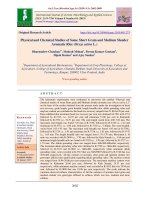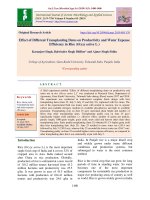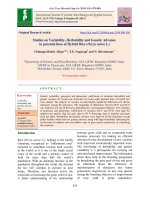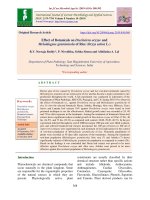Performance of rice (Oryza sativa L.) hybrids under different nitrogen levels during wet season in new alluvial zone of West Bengal
Bạn đang xem bản rút gọn của tài liệu. Xem và tải ngay bản đầy đủ của tài liệu tại đây (208.09 KB, 6 trang )
Int.J.Curr.Microbiol.App.Sci (2020) 9(7): 2352-2357
International Journal of Current Microbiology and Applied Sciences
ISSN: 2319-7706 Volume 9 Number 7 (2020)
Journal homepage:
Original Research Article
/>
Performance of Rice (Oryza sativa L.) Hybrids under Different Nitrogen
Levels during Wet Season in New Alluvial Zone of West Bengal
Megha Sana1*, Rumi Saha1, Subhajit Pal2, Sukanta Pal1 and Krishnendu Mondal1
1
Department of Agronomy, Faculty of Agriculture, Bidhan Chandra Krishi Viswavidyalaya,
Mohanpur- 741252, Nadia, West Bengal, India
2
Department of soil Science and Agricultural Chemistry, Faculty of Agriculture, Dr. Rajendra
Prasad Central Agricultural University, Pusa (Samastipur), Bihar- 848125
*Corresponding author
ABSTRACT
Keywords
Oryza sativa,
Nitrogen levels,
kharif seasons,
N4 level
Article Info
Accepted:
20 June 2020
Available Online:
10 July 2020
Effect of rice hybrids to nitrogen levels was studied during kharif seasons
of 2018 and 2019 at Regional-Research Sub-Station (RRSS) Chakdaha of
BCKV under new alluvial zone of West Bengal. The experiment was laid
out in Factorial Randomized Block Design (FRBD) with 10 treatment
combinations having with two hybrid rice varieties viz., V1 (PAN 2112
Gold), V2 (KRH-2) and five nitrogen levels viz. N1 (0:60:60 N: P2O5: K2O
Kg/ha), N2 (50:60:60 N: P2O5: K2O Kg/ha), N3 (100:50:50 N: P2O5: K2O
Kg/ha ), N4 (150:60:60 N: P2O5: K2O Kg/ha), N5 (200:60:60 N: P2O5: K2O
Kg/ha with four replicates. Experimental results revealed that almost all the
growth parameters gave significantly superior performance in the variety
PAN 2112 Gold and N4 level of fertilization. The maximum grain yield
(5.10t/ha) was recorded in the variety V1 in combination with N4 level of
nitrogen which were 6.69% more than KRH-2. Highest harvest index
(50.86%) was noticed in same treatment combination.
Introduction
Rice (Oryza sativa L.) is an important cereal
crop and grown across the world. It is an
important cereal crop next to wheat which
accounts for the major dietary energy
requirement of Asian rural people as more
than 90% of rice is grown and consumed in
Asia. It is a principal source of food for more
than half of the world’s population and also
predicted that a 50 - 60 % increase in rice
production will be required to meet demand
from population growth by 2025. To sustain
the self sufficiency in coming decades, the
production of rice needs to be increased every
year by almost 2 million tonnes. The
challenging task of plateauing trend observed
in yield potential of high yielding rice
varieties and decreasing natural resource base
can be done by hybrid rice technology. This
2352
Int.J.Curr.Microbiol.App.Sci (2020) 9(7): 2352-2357
increase in production should be achieved
without disturbing the delicate environmental
base. Many genetic approaches being
explored to break the yield barrier in rice,
hybrid rice technology appears to be the most
feasible and readily adaptable one. Rice
hybrid produces about 14-28% higher grain
yield than inbred cultivars (Siddiq, 2006). In
west Bengal the yield potential of hybrid rice
is 4-6 t/ha during kharif season. Earlier it was
mainly concentrated in North Bengal districts
like Coochbehar, Jalpaiguri, Malda, North
and South Dinajpur but now it is cultivated in
South Bengal districts like Purulia, Bankura,
South 24 Pgs, Nadia etc.
Nutrient requirement of hybrid rice is
generally more than the high yielding
varieties. It is recommended after the
evaluating of soil nutrient status. Inorganic
fertilizers especially nitrogen plays an
important role towards cultivation of hybrid
rice. Inadequate nitrogen in soil results in
reduced leaf area, limiting light interception
thereby causing reduced photosynthesis
which finally give poor biomass growth and
grain yield (Sinclair, 1990). As nitrogen
fertilizer is important for the grain yield of the
rice plant it is necessary to know what the
best dose is for each variety as well as its
influence on components of yield. Different
variety shows different yield potential of
hybrid rice at different nitrogen doses.
Therefore, present investigation was carried
out with a view to develop a package
involving optimization of nitrogen doses and
variety for the overall improvement of
productivity of hybrid rice.
Materials and Methods
A field experiment was conducted in 2018
and 2019 during two consecutive wet seasons
of at Regional Research Sub-Station,
Chakdaha under Bidhan Chandar Krishi
Viswavidyalaya West Bengal. The climate of
the experimental site is humid subtropical
with hot humid, long summer and mild short
winter. The experiment was conducted under
irrigated shallow medium land situation,
having medium fertility status with good
drainage facility. The soil of the experimental
field was sandy clay loam in texture (Entisol)
with pH 7.0, EC 0.61 ds m -1, organic carbon
0.38%, available N 184 kg ha-1, available P
16.00 kg ha-1and available K 126.10 kg ha-1.
The experiment was laid out in Factorial
Randomized Block Design (FRBD) with 3
(three) replicates. The 4 m × 3 m
experimental plots were made with 0.5 m
bunds leaving 1 m irrigation channel in
between. Hybrid rice varieties used in the
experiment were PAN 2112 Gold and KRH-2.
Five levels of nitrogen [Control, 50 kg/ha
nitrogen, 100 kg/ha nitrogen, 150 kg/ha
nitrogen and 200 kg/ha nitrogen] were applied
to prescheduled experimental plots. 60 kg/ha
P2O5 and 60 kg/ha K2O are common in all the
above treatments. One fourth of total N, entire
amount of P and three fourths of K were
applied as basal after draining out the
standing water but before final puddling.
Remaining N was top dressed in three equal
splits, each at three weeks after transplanting,
panicle initiation and panicle emergence
stages. Remaining one fourth of K was also
applied at panicle initiation stage. Well
germinated seeds of hybrid rice (var. PAN
2112 Gold and KRH-2) @ 15 g/m2 were and
23 days old seedlings were transplanted. The
seedlings were uprooted and transplanted at
the spacing of 20 cm x 15 cm. Single seedling
were planted hill-1 at a depth of 2-3 cm as per
all treatments. Nitrogen, phosphorus and
potash in the form of urea, single super
phosphate and muriate of potash were applied
as per treatment. Gap filling was done seven
days after transplanting to keep same plant
population density for every plot. All other
cultural and plant-protection measures were
also adopted as recommended for the region
(Banerjee and Pal, 2009). The crop was
2353
Int.J.Curr.Microbiol.App.Sci (2020) 9(7): 2352-2357
harvested when the plant become yellowish to
brown and had around 14% grain moisture
level. Data on different yield components
were recorded at harvest. Plot-wise crops
were harvested threshed. Grain and straw
were then properly sun-dried, weighed and
finally converted into t/ha. Plant samples from
each treatment were collected, oven-dried,
and ground for analyzing total recoveries of
N, P and K at harvesting following standard
procedures.
Results and Discussion
Growth parameters of rice
There was a significant influence of all
growth parameters like plant height, number
of tillers/m2, LAI, DMA, chlorophyll content
and CGR. PAN 2112 Gold showed the
highest result over KRH-2. PAN 2112 Gold
showed more chlorophyll content than KRH-2
might be due to the varietal characters.
Influence of nitrogen level was also
significant in case of all growth parameters
namely plant height, number of tillers/m2,
LAI, DMA, chlorophyll content and CGR
(Table 1) and application of 150 kg N/ha
showed the best result accounting 12.9, 35.8,
31.8, 52.5, 10.4 and 41.05 % increase over
control respectively. Similar findings were
also reported by Mishra et al., (2003), more
nitrogen availability encourage carbohydrate
synthesis. Except number of tillers/m2 and
chlorophyll content all growth parameters
showed significant result in case of
combination approach. All the measured yield
attributes were higher under the PAN 2112
Gold in combination with 150 kg N/ha level.
Similar observations were also reported by
Pandey et al., (2007), Bera and Pramanik
(2013) and Singh et al., (2009).
Yield and harvest index
the varieties and different levels of nitrogen.
The grain yield of variety PAN 2112 Gold
(5.10 t/ha) was 6.69% higher than KRH-2.
The difference in their yield was due to their
variation in yield component. Highest straw
yield and harvest Index was 6.10 t/ha and
44.96% respectively in case of PAN 2112
Gold variety (Table 2). Regarding nitrogen
levels highest grain yield (6.27 t/ha) showed
with the application of N4 (i.e.150:60:60 N:
P2O5: K2O Kg/ha) nutrient level which was
85.50% more than the control treatment. But
the highest straw yield was recorded from N5
level of nitrogen dose i.e. 200 kg/ha. There
was progressive and significant increase in
straw yield with each incremental dose of
nitrogen applied during the course of
investigation. It is also observed that
increasing trend of nitrogen level increased
yield (Jaswal et al., 2001). Except the grain
yield the interaction between varieties and
nitrogen levels was statistically significant in
case of straw yield and harvest Index. PAN
2112 Gold in combination with 100 kg N/ha
gave the highest straw yield.
Nutrient uptake
Total nutrient uptake by grain and straw
varied significantly with the varieties,
nitrogen levels and interaction effect between
variety and nitrogen in case of total nitrogen
and phosphorus but total potassium uptake by
grain and straw did not show any significant
relationship among varieties. In nitrogen
levels and interaction effect there were
significant difference in values in case of total
potassium uptake. V1 showed higher value
(96.57 kg/ha) than KRH-2 (91.90 kg/ha)
towards N uptake but KRH-2 had significant
superior value (30.78 kg/ha) than PAN 2112
Gold (30.26 kg/ha) for total P uptake (Table
3). Among five nitrogen levels N4 i.e. 150 kg
N/ha recorded maximum value in case of total
N, P, K uptake.
The grain yield, straw yield and harvest index
of paddy hybrid significantly varied among
2354
Int.J.Curr.Microbiol.App.Sci (2020) 9(7): 2352-2357
Table.1 Effect of nitrogen levels and varieties on growth parameters of hybrid rice during wet
season (Pooled value of 2 years)
Nitrogen
management
Plant height at 75 DAS No. of tillers/m2 at 75 DAS
LAI at 75 DAS
Variety
V1
V2
Mean
V1
V2
Mean
V1
V2
Mean
N1
100.49
99.13
99.81
369.93
344.85
357.39
2.85
2.80
2.83
N2
103.82
104.89
104.36 419.15
376.20
397.67
2.95
2.85
2.90
N3
105.11
107.96
106.54 438.90
410.69
424.79
3.60
3.50
3.55
N4
112.95
112.40
112.68 493.67
477.30
485.48
3.75
3.70
3.73
N5
108.31
110.48
109.40 466.17
448.31
457.24
3.85
3.80
3.83
Sem±
CD 5%
Sem±
CD
5%
Sem±
CD 5%
N
0.038
0.112
3.743
10.920
0.004
0.013
V
0.024
0.071
2.367
6.906
0.003
0.008
NxV
0.054
0.158
5.294
NS
0.006
0.018
Nitrogen
management
DMA at 75 DAT
Chlorophyll content 75
DAT
CGR at 25-50 DAT
Variety
V1
V2
Mean
V1
V2
Mean
V1
V2
Mean
N1
720.95
702.27
711.61
1.92
1.93
1.93
19.07
19.51
19.29
N2
761.01
895.73
828.37
1.97
1.73
1.85
19.89
25.58
22.74
N3
890.49
895.73
893.11
1.81
1.83
1.82
21.45
23.65
22.55
N4
1092.5
1078.6
1085.5
2.16
2.10
2.13
26.44
27.98
27.21
N5
898.89
1075.2
987.07
2.39
2.20
2.30
21.16
28.22
24.69
Sem±
CD 5%
Sem±
CD 5%
Sem±
CD 5%
N
73.29
217.67
0.023
0.068
1.81
5.382
V
48.14
137.67
0.015
0.043
1.19
3.404
NxV
105.78
307.83
0.033
NS
2.62
7.612
V1= PAN 2112 Gold, V2= KRH-2, N1=Control, N2=50:60:60 kg/ha, N3=100:60:60 kg/ha, N4=150:60:60 Kg/ha,
N5=200:60:60 kg/ha
2355
Int.J.Curr.Microbiol.App.Sci (2020) 9(7): 2352-2357
Table.2 Effect of nitrogen levels and varieties on yields (t/ha) and harvest index (%) of hybrid
rice (Pooled value of 2 years)
Nitrogen
management
Grain yield (t/ha)
Straw yield (t/ha)
Harvest index (%)
Variety
V1
V2
Mean
V1
V2
Mean
V1
V2
Mean
N1
3.46
3.30
3.38
5.47
5.34
5.41
38.76
38.20
38.48
N2
4.06
3.99
4.03
5.84
5.46
5.65
41.02
42.23
41.63
N3
5.59
4.86
5.23
6.6
6.02
6.31
45.86
44.66
45.26
N4
6.58
5.95
6.27
6.36
6.2
6.28
50.86
48.98
49.92
N5
5.83
5.79
5.81
6.24
6.48
6.36
48.32
47.20
47.76
Sem±
CD 5%
Sem±
CD
5%
Sem±
CD 5%
N
0.146
0.425
0.012
0.036
0.077
0.224
V
0.092
0.269
0.008
0.023
0.121
0.354
NxV
0.206
NS
0.018
0.051
0.172
0.501
V1= PAN 2112 Gold, V2= KRH-2, N1=Control, N2=50:60:60 kg/ha, N3=100:60:60 kg/ha, N4=150:60:60 Kg/ha,
N5=200:60:60 kg/ha
Table.3 Effect of nitrogen levels and varieties on N uptake (kg/ha), P uptake (kg/ha) and K
uptake (kg/ha) of grain + straw after harvest of hybrid rice (Pooled value of 2 years)
Nitrogen
management
N1
N2
V1
62.32
73.69
V2
59.07
77.72
Mean
60.70
75.21
P uptake
Variety
V1
V2
Mean
24.50
24.60
24.55
27.05
26.61
26.83
N3
88.61
95.95
92.28
29.50
27.84
28.67
N4
140.4
0
109.7
0
Sem±
134.15
137.2
8
105.2
1
40.56
39.02
39.79
31.70
33.82
32.76
CD 5%
Sem±
0.426
0.269
0.602
1.242
0.785
1.756
0.087
0.055
0.123
CD
5%
0.253
0.160
0.358
N5
N
V
NxV
N uptake
100.71
K uptake
V1
84.60
102.8
4
107.2
6
124.9
7
118.0
2
Sem±
V2
89.04
100.20
CD 5%
0.148
0.094
0.209
0.432
NS
0.610
104.25
123.90
118.31
Mean
86.82
101.5
2
105.7
5
124.4
4
118.1
6
V1= PAN 2112 Gold, V2= KRH-2, N1=Control, N2=50:60:60 kg/ha, N3=100:60:60 kg/ha, N4=150:60:60 Kg/ha,
N5=200:60:60 kg/ha
2356
Int.J.Curr.Microbiol.App.Sci (2020) 9(7): 2352-2357
The maximum values of N, P, K uptake were
137.28 kg/ha, 39.79 kg/ha, 124.44 kg/ha
respectively. The least values were observed
in control plot where no nitrogen was applied
and the percent increase over control to the
N4 treatment in case of N, P, K uptake were
126.16, 62.07, 43.31 respectively. Regarding
interaction effect between variety and
nitrogen levels PAN 2112 Gold recorded
significantly highest value in combination
with 150 kg N/ha towards total NPK uptake
by grain and straw. KRH- 2 variety also
showed highest value in combination with N4
level of fertilization.
The investigation concludes with the finding
PAN 2112 Gold can be recommended for
South Bengal locations contributing a yield of
5.10 t/ha as an Aman crop. Hybrid rice
responds up to 150 kg/ha of Nitrogen
application. These two factors in combination
can be recommended to the farmers.
References
Banerjee, H. And Pal, S. 2009. Integrated
nutrient management for rice rice
cropping system. Oryza. 46 (2-36).
Bera,-A-K; Pramanik,-K (2013). Response of
rice hybrids to nitrogen levels under
lateritic zone of West Bengal, India.
International-Journal-of-Bio-resourceand- Stress-Management.; 4(2): 161165.
Jaiswal, V. P. and Singh G. R. 2001. Effect of
planting methods and levels of nitrogen
on the growth and yield of rice and on
succeeding wheat. Indian Journal of
Agronomy. 46(1): 5-11.
Mishra, B., Viraktamath, B.C., ahmed, M.I.,
Ramesha, M.S., Vijayakumar, C.H.M
May,-2002.
(2003)
Hybrid
rice
development and use in India Hybridrice-forfood-security,-povertyalleviation-and-environmentalprotection-Proceedingsof-the-4thInternational-Symposium-on-HybridRice,Hanoi,Vietnam,14-170265- 268.
Pandey N, Verma AK, and Tripathi RS.
(2007). Evalution of different nutrient
management
practices
on
the
performance of rice hybrid during dry
season. Oryza. 44 (4) : 311- 314.
Siddiq, E.A. 2006. Rice production strategy
for the 21st century, Oryza, 30: 186196.
Sinclair, T.N. 1990. Nitrogen influence on the
physiology of crop yield. In: Theoretical
Production Ecology: Reflections and
Prospects (Eds.: R. Rabbinge, J.
Goudriaan, H. van Keulen, F.W.T.P. de
Vries, H.H. van Laar). Pudoc
Wageningen, p.41-55.
Singh, A.K., Chandra, U. And Singh, T.
(2009). Effect of different fertilizer
levels on chlorophyll content, growth
and yield of hybrid rice. Annals-ofPlant- Physiology 23(1): 77-79.
How to cite this article:
Megha Sana, Rumi Saha, Subhajit Pal, Sukanta Pal and Krishnendu Mondal. 2020.
Performance of Rice (Oryza sativa L.) Hybrids under Different Nitrogen Levels during Wet
Season in New Alluvial Zone of West Bengal. Int.J.Curr.Microbiol.App.Sci. 9(07): 2352-2357.
doi: />
2357









